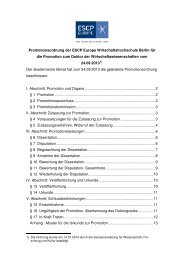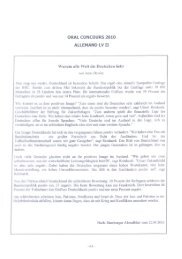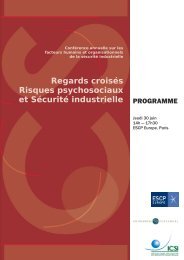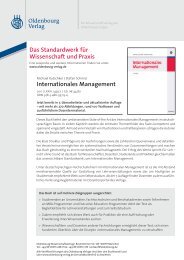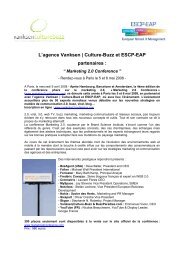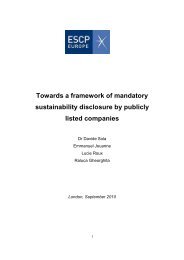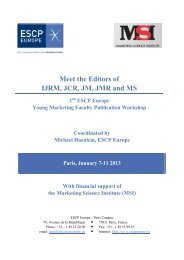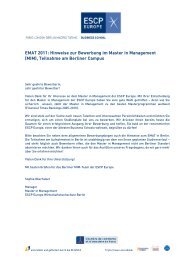WP 53_Jacob_neu - ESCP Europe Business School
WP 53_Jacob_neu - ESCP Europe Business School
WP 53_Jacob_neu - ESCP Europe Business School
You also want an ePaper? Increase the reach of your titles
YUMPU automatically turns print PDFs into web optimized ePapers that Google loves.
more complex” (p.565). We follow Duncan (1972) and Pfeffer and Salancik<br />
(1978) that complexity is defined in terms of the perception of decision makers.<br />
Individuals have different perceptions and tolerance for ambiguity and uncertainty<br />
(Adorno, Frenkel-Brunswik, and Levinson 1950; Berlyne 1968). 8<br />
Although the analysis of the ramifications of complexity on decision making is<br />
far from being innovative, studies in business-to-business contexts are rare. As<br />
Wynstra, Axelsson, and van der Valk (2006) succinctly note: “Finally, hardly any<br />
research is published that deals with the variety of business services from the<br />
buyer’s perspective, and which examines how buyers deal with this variety”<br />
(p.475). 9<br />
3.2 Co-creation<br />
Our second defining element of industrial market offerings is the degree to which<br />
production processes are split between supplier and customer. This phenomenon<br />
has been treated under “co-production” (Auh et al. 2007; Ramirez 1999;<br />
Normann and Ramirez 1993), “customer participation” (Dabholkar 1990), “coconstructing”<br />
(Sawhney 2006), “co-creation” (Cova and Salle 2007; Vargo and<br />
Lusch 2004), and customer integration (e.g., Kleinaltenkamp and <strong>Jacob</strong> 2002).<br />
Interestingly, co-creation has been mainly researched in consumer markets, with<br />
slim evidence from business markets (Payne, Storbacka, and Frow 2008). This is<br />
an important point, since whereas in consumer markets co-creation is an<br />
opportunity for a firm to achieve competitive advantage (Auh et al. 2007), in<br />
industrial markets, the customer integration is oftentimes a necessity (Dhar,<br />
Menon, and Maach 2004); customers “often demand special value-adding<br />
activities from their suppliers, such as joint product development, advanced<br />
personal interaction, or consulting services” (Stock 2006, p.588).<br />
Research on co-creation can be classified according to three research<br />
questions: (a) research focusing on the benefits of customer participation for the<br />
firm in terms of productivity (e.g., Blazevic and Lievens 2008; Payne and Frow<br />
2005), (b) research focusing on what and when customers can be used for<br />
participation in production processes (e.g., Meuter et al. 2005), and (c) the<br />
psychological effects of participation in production processes on customers (e.g.,<br />
Bendapudi and Leone 2003). According to latter authors research “has not<br />
addressed customers’ potential psychological responses to participation” (p.14).<br />
Even if we would adapt research on co-creation in consumer markets, its effects<br />
on DMU or its interplay with (market-offering) complexity have not been tested so<br />
far (Hsieh, Yen, and Chin 2004). We argue that co-creation has a positive impact<br />
8 Hence, testing an objective state of market-offering complexity would not be<br />
conducive for our research purpose; “It is probably an epistemological misnomer to<br />
say that environments are uncertain. It is the organization that is uncertain about its’<br />
environment” (Achrol, Reve and Stern, 1983, p.59).<br />
9 Note, that – according to our understanding – variety is only one facet of market-<br />
offering complexity.<br />
7



